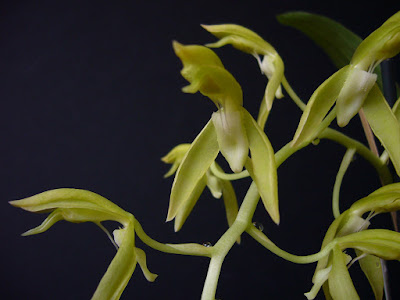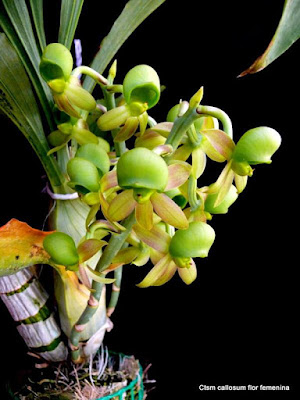Catasetum callosum is found in Brazil, Amazonas State (along the border with Colombia and Peru), through Venezuela and the Guianas. It grows in gallery forest along the tributaries on the left bank of the Amazon River at elevations of about 346 meters. It is also found on more open plains in the other northern South American countries.
Catasetum callosum also called as The Callous Catasetum, Catasetum acallosum, Catasetum arachnoides, Catasetum callosum var. carunculatum, Catasetum callosum var crenatum, Catasetum callosum var crenulatum, Catasetum callosum var grandiflorum, Catasetum carunculatum, Catasetum darwinianum, Catasetum fuliginosum, Catasetum fuliginosum, Catasetum lansbergii, Myanthus callosus, Myanthus grandiflorus, Myanthus lansbergii, is a species of the genus Catasetum. This species was described by John Lindley in 1840.
IDENTIFY CATASETUM CALLOSUM ORCHID PLANT
Catasetum callosum is found in Brazil, Amazonas State (along the border with Colombia and Peru), through Venezuela and the Guianas. It grows in gallery forest along the tributaries on the left bank of the Amazon River at elevations of about 346 meters. It is also found on more open plains in the other northern South American countries.
It is a medium sized, hot growing epiphytic species with fusiform, 10 cm long and 2.5 cm wide pseudobulbs enveloped basally by leaf sheaths and carrying 5, linear-lanceolate, medium green, plicate, 24 cm long and 4 cm wide leaves.
The Callous Catasetum blooms in the fall and winter on a basal, arching, 30 cm long, 10 to 15 flowered, racemose inflorescence with fragrant, inverted flowers arising on a mature pseudobulb. The male flowers are 3.5 cm in diameter. Coloration of peduncle and pedicels green (to dark maroon in darker-colored clones); sepals and petals light green (from light to dark green and brown in other clones); lip cream-colored to white (from light to dark green and brown in other clones); column darker cream-colored to yellow-green. The female flowers are not seen.
Some varieties of this orchid: var. carunculatum (lip shorter and wider than the other segments, toothed, with a yellow callus at the base), var. crenulatum (lip oblong-oval or almost fiddle-shaped, the margins, mainly in front, coarsely toothed, and the apex of the midlobe tridentate, and verrucose above), and var. typum (lip oblong-oval or trilobed, the margins noticeably notched, the midlobe smooth).
CATASETUM CALLOSUM ORCHID PLANT CARE AND CULTURE
Cultural information should only be used as a guide, and should be to be adapted to suit you. Your physical location; where you grow your plants, how much time you have to devote to their care, and many other factors, will need to be taken into account. Only then can you decide on the cultural methods that best suit you and your plants.
Light:
Catasetum callosum are sun-loving plant (bright light) and needs a light level of 30000-60000 lux. This species can be grown under lights if sufficient light intensity can be provided, and the plant certainly can be summered outdoors if their moisture requirements can be met.
Temperature:
In their natural habitat, the climate is evenly hot, moist, and tropical. This climate is almost the same year-round, with high humidity at night, even in the dry season, which is relatively short. The nighttime temperatures rarely fall below 18°C, with daytime highs generally from 29 to 35°C. The important thing is to maintain evenly warm conditions, and for this orchid the closer the night minimum is to 21°C, the better the plants will respond.
Humidity:
The Callous Catasetum tolerate an environment with 40 - 60 % relative humidity during their growing season, but for optimal development of new growth and flowering, 70 % is recommended.
Substrate, growing media and repotting:
Catasetum callosum can be grown in pot, container or wooden basket with fir bark, osmunda, tree fern fiber, charcoal, and sphagnum, in various proportions or combined with still other ingredients such as sponge rock, perlite, leaf mold, peat, and bark screenings as substrate. This plant can also mounted on wood. This option presupposes that the plant is sufficiently strong, that it is not so large as to be unwieldy when hanging from its mount, that the grower can provide adequate humidity for it during the growing season, that the conversion to mounting is done at the very beginning of the growth cycle, and that the species is known to adapt readily to this cultural practice.
It is recommended to repot every year and never wait more than two years. The optimal time for potting or repotting is when new growth on a plant emerging from dormancy is about 5 cm tall and the nubs have developed into new roots that are reaching for support.
Watering:
In its natural habitat it receives rainfall frequently even while dormant. Mounted, basket-grown, and unconventionally potted plant may be watered every sunny day during the growing season, provided conditions are such that they dry off relatively quickly. In the case of conventionally potted adult plants, it should not be necessary to water more than once or, at most, twice a week. This species like to dry out at least slightly between waterings.
Fertilizer:
Fertilize with an appropriate formulation at least every week during the growing season, or fertilize with a weak formula every time the plants are watered. It is important to begin regular applications of high-nitrogen fertilizer (such as 10-5-5) with a full range of trace elements. As the leaves begin to unfurl, and well before flowering, add a high-phosphorus formula to develop big, strong pseudobulbs capable of producing robust inflorescences. Any of the soluble products with a large second-digit number (for example, 3-12-6) constitute a good source of phosphorus.
Rest period:
When the Catasetum callosum plants are leafless and no new growths are visible, the grower must respect their state of dormancy. Watering frequency should be reduced during dormancy. Fertilization should stop completely during this period. In the springtime, at the beginning of the growth cycle, water should not be made regularly available for the newly developing roots until the new growth is at least 5 cm tall.















COMMENTS